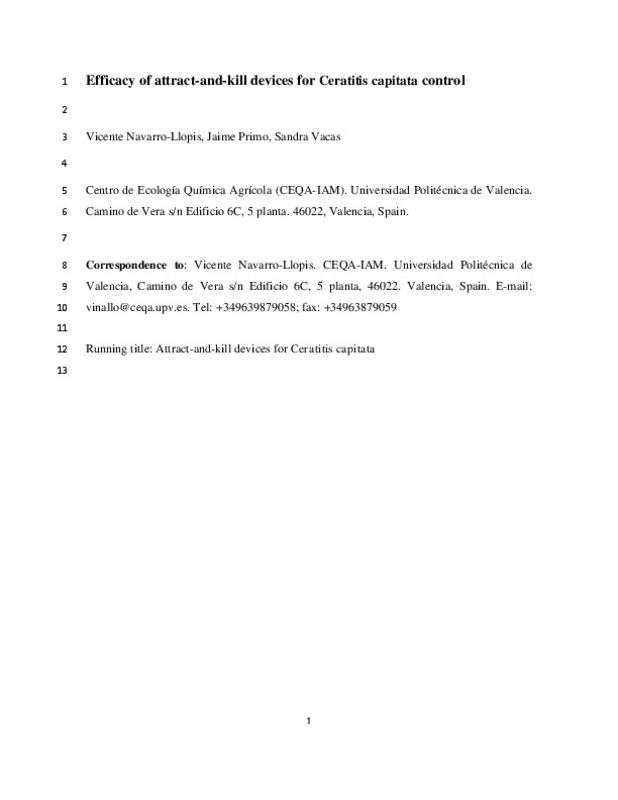JavaScript is disabled for your browser. Some features of this site may not work without it.
Buscar en RiuNet
Listar
Mi cuenta
Estadísticas
Ayuda RiuNet
Admin. UPV
Efficacy of attract-and-kill devices for the control of Ceratitis capitata
Mostrar el registro sencillo del ítem
Ficheros en el ítem
| dc.contributor.author | Navarro-Llopis, Vicente
|
es_ES |
| dc.contributor.author | Primo Millo, Jaime
|
es_ES |
| dc.contributor.author | Vacas González, Sandra
|
es_ES |
| dc.date.accessioned | 2017-05-02T08:56:35Z | |
| dc.date.available | 2017-05-02T08:56:35Z | |
| dc.date.issued | 2013-04 | |
| dc.identifier.issn | 1526-498X | |
| dc.identifier.uri | http://hdl.handle.net/10251/80299 | |
| dc.description.abstract | BACKGROUND: The control of Ceratitis capitata Wiedemann traditionally has relied on chemical control with organophosphate insecticides. The use of many of these substances has been banned by new European directives; therefore, the development of new controlmethods is essential to manage this pest. Bait sprays with spinosad,mass trapping and lure-and-kill techniques have been the base for new integrated pest management programmes. In this study, a 2 year field trial was conducted in two citrus areas to test the efficacy of attract-and-kill devices against mass trapping and spinosad-plus-bait treatments. RESULTS: TheMagnet MEDattract-and-kill device, Spintor treatments andmass trapping achievedgoodcontrolof C. capitata populations, as confirmed by low percentages of damaged fruit in the assessments performed during the harvest period. On the other hand, fly population levels on plots treated with other attract-and-kill prototype devices increased more than threefold by comparison with the populations recorded in the rest of the treated plots. The same effect was observed for fruit damage, with 6 8 times less damage with Magnet MED and spinosad treatments, respectively, than with the attract-and-kill prototype devices. CONCLUSION: By using an effective attractant, conventional trapping systems can be replaced with cheaper and easier-tohandle attract-and-kill devices. The efficacy of these devices and their advantages over conventional mass trapping systems are discussed. | es_ES |
| dc.description.sponsorship | This research was funded in part by the Atomic International Energy Agency through research contract No. 15726, Ecologia y Proteccion Agricola SL and by the Conselleria d'Agricultura, Peixca i Alimentacio (GVA). | en_EN |
| dc.language | Inglés | es_ES |
| dc.publisher | Wiley | es_ES |
| dc.relation.ispartof | Pest Management Science | es_ES |
| dc.rights | Reserva de todos los derechos | es_ES |
| dc.subject | Ceratitis capitata | es_ES |
| dc.subject | Attract and kill | es_ES |
| dc.subject | Bait station | es_ES |
| dc.subject | Mass trapping | es_ES |
| dc.subject | Fruit fly | es_ES |
| dc.subject.classification | QUIMICA ORGANICA | es_ES |
| dc.title | Efficacy of attract-and-kill devices for the control of Ceratitis capitata | es_ES |
| dc.type | Artículo | es_ES |
| dc.identifier.doi | 10.1002/ps.3393 | |
| dc.relation.projectID | info:eu-repo/grantAgreement/IAEA//15726/ | es_ES |
| dc.rights.accessRights | Abierto | es_ES |
| dc.contributor.affiliation | Universitat Politècnica de València. Instituto Agroforestal Mediterráneo - Institut Agroforestal Mediterrani | es_ES |
| dc.contributor.affiliation | Universitat Politècnica de València. Escuela Técnica Superior de Ingenieros Industriales - Escola Tècnica Superior d'Enginyers Industrials | es_ES |
| dc.description.bibliographicCitation | Navarro-Llopis, V.; Primo Millo, J.; Vacas González, S. (2013). Efficacy of attract-and-kill devices for the control of Ceratitis capitata. Pest Management Science. 69(4):478-482. doi:10.1002/ps.3393 | es_ES |
| dc.description.accrualMethod | S | es_ES |
| dc.relation.publisherversion | http://dx.doi. org/10.1002/ps.3393 | es_ES |
| dc.description.upvformatpinicio | 478 | es_ES |
| dc.description.upvformatpfin | 482 | es_ES |
| dc.type.version | info:eu-repo/semantics/publishedVersion | es_ES |
| dc.description.volume | 69 | es_ES |
| dc.description.issue | 4 | es_ES |
| dc.relation.senia | 248640 | es_ES |
| dc.contributor.funder | Ecología y Protección Agricola S.L. | es_ES |
| dc.contributor.funder | Generalitat Valenciana | es_ES |
| dc.contributor.funder | International Atomic Energy Agency | es_ES |






![[Cerrado]](/themes/UPV/images/candado.png)


